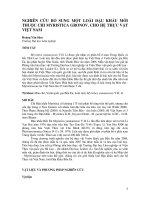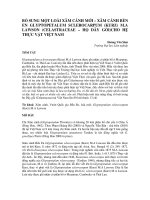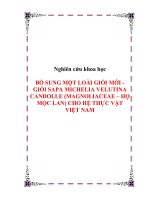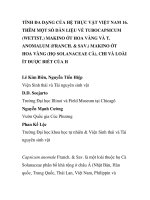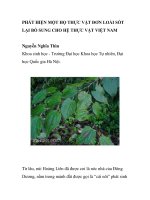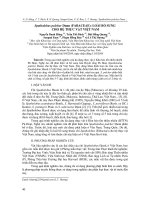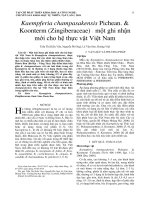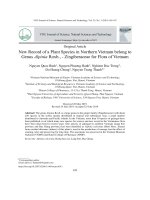GHI NHẬN MỚI LOÀI Edgeworthia tomentosa (Thunb.) Nakai. Họ (Thymelaeaceae) CHO HỆ THỰC VẬT VIỆT NAM
Bạn đang xem bản rút gọn của tài liệu. Xem và tải ngay bản đầy đủ của tài liệu tại đây (368.09 KB, 4 trang )
<span class='text_page_counter'>(1)</span><div class='page_container' data-page=1>
<i>Nguyễn Thị Vân và Đtg </i> Tạp chí KHOA HỌC & CƠNG NGHỆ 180(04): 49 - 52
49
<i><b>Edgeworthia tomentosa (Thunb.) Nakai. (Thymelaeaceae): A NEWLY RECORDED </b></i>
<b>SPECIES FOR THE FLORA OF VIETNAM </b>
<b>Nguyen Thi Van1, Tran Duc Binh2, Sy Danh Thuong3, Bui Hong Quang2* </b>
<i>1</i>
<i><b>Bacgiang Agriculture and Forestry University, </b></i>
<i>2</i>
<i>Institite of Ecology and Biological Resources - Vietnam Academy of Science and Technology, </i>
<i>3</i>
<i>TNU- University of Education</i>
SUMMARY
Thymelaeaceae has 48 genera and ca. 650 species, widely distributed in both hemispheres.
<i>Edgeworthia is a small genus of Thymelaeaceae, about 5 species, only distribution in Asia </i>
(Bhutan, China, India, Japan, Myanmar, Nepal, Vietnam). Among 5 species, there are 3 endemic
<i>species in China. In Vietnam, this genus has only 1 species - E. gardneri (Wall.) Meisn., only </i>
<i>distribution in Khanh Hoa. In this paper, E. tomentosa (Thunb.) Nakai., a new record of </i>
Thymelaeaceae, is described and color photographs from the material collected in Sang Ma Sao
Village, Muong Hum Commune, Bat Xat District, Lao Cai Province, Vietnam. So far, this species
only distributes in China (forests, shrubby slopes and also cultivated in Fujian, Guangdong,
Guangxi, Guizhou, Henan, Hunan, Jiangxi, Yunnan, Zhejiang) and Japan (cultivated and
naturalized). This paper also mentions the conservation status of the species and discussion on
<i>different morphological characters between E. tomentosa and E. gardneri. </i>
<i><b>Key words: Edgeworthia, Edgeworthia tomentosa, Lao Cai, new record, Vietnam</b></i>
INTRODUCTION*
<i>So far, the genus Edgeworthia Meisner and </i>
<i>the species E. tomentosa (Thunb.) Nakai. </i>
belong to Thymelaeaceae, was known
including about 4 species and distributed in
Asia (China, Japan) [3], [4], [7]. So far, there
<i>is only one species (E. tomentosa (Thunb.) </i>
Nakai.) in Vietnam [1], [5]. In 2017, during
investigation in Bat Xat District, Lao Cai
<i>Province, Vietnam, we found a Edgeworthia </i>
plant small tree, an interesting species of
Thymelaeaceae was encountered. Hence, we
report this species as a new distributional
record for the flora of Vietnam, with a single
population found in the primary broad-leaved
evergreen closed forest, nearby waterfall in
Lao Cai Province, not common in the studied
areas. More extensive field surveys are
<i>needed to find more E. tomentosa populations </i>
that probably exist somewhere in similar
habitats in this studied areas. This work will
provide insight for conservation and
management of rare and threatened plant
species in Vietnam. The taxonomic
description, color photographs, distribution,
*
<i>Tel: 0982 166390; Email: </i>
ecology, phenology and conservation of this
species are provided to facilitate its easy
identification (fig. 1). This species is
morphologically most similar to <i>E. </i>
<i>tomentosa, in having erect small tree to 2 - 3 </i>
m tall, leaves membranaceous, elliptic to
obovate. However, this species can be
differentiated from the inflorescences;
peduncle 1 - 2 cm, grayish white hirsute;
bracts ca. 10, pilose; flowers fragrant; calyx
yellow inside, 13 - 20 × 4 - 5 mm, tube
exterior densely white sericeous, lobes 4,
<i>ovate-lanceolate, ca. 3.5 × 3 mm. In E. </i>
<i>gardneri: inflorescences peduncle pendulous, </i>
2 - 2.5 (-5) cm, white sericeous at anthesis,
glabrescent; bracts caducous, leaflike,
narrowly lanceolate; calyx ca. 15 mm) [7]
(see table 1).
MATERIALS AND METHODS
<b>Materials: Plants mentioned in this paper </b>
were collected during field studies in 2017.
Herbarium specimens of each studied species
are presently housed in Hanoi.
<b>Methods: Observations of flowers were made </b>
</div>
<span class='text_page_counter'>(2)</span><div class='page_container' data-page=2>
<i>Nguyễn Thị Vân và Đtg </i> Tạp chí KHOA HỌC & CƠNG NGHỆ 180(04): 49 - 52
50
for subsequent studies and preparation of
herbarium specimens. They were fixed and
preserved in 50 - 60% ethanol. Measurements
of floral parts for description were made on
both living and liquid-preserved materials.
Fresh flowers or floral parts were found to
shrink up to ca 15 - 20% in size in the drying
process of making herbarium specimens. This
was taken into account when dried herbarium
specimens were identified. In describing
quantitative characters, infrequent extreme
values (i.e. rarely occurring minimum and
maximum values) of a variation range are
parenthesized before and after a normal
variation range respectively.
RESULTS AND DISCUSSION
<i><b>Key species Edgeworthia in Vietnam </b></i>
<b>1a. </b> Leaves deciduous, absent at
<i><b>flowering………..1. E. tomentosa </b></i>
<b>1b. Leaves evergreen or biennial, present at </b>
<i><b>flowering……….2. E. gardneri </b></i>
<b>Taxonomic Treatment: </b>
<b>Edgeworthia tomentosa (Thunb.) Nakai in </b>
Bot. Mag. Tokyo 33: 206. 1919, et in Journ.
Am. Arb. 5: 82. 1924 (Fig. 1)
<i>- E. gardneri auct non Meisn: Hook. f. Fl, </i>
Brit. Ind. 5: 195. 1886, p. p. ; Hemsl. in
Journ. Linn. Soc. Bot. 26: 396. 1891.
<i>- E. papyrifera (Sieb.) Sieb. et Zucc. in </i>
Abh. Bay. Akad. Wiss. Math. Phys. 4 (3):
199. 1846.
Shrubs or tree to 1.5 - 2 m tall, deciduous,
branching usually trichotomous. Branchlets
brown, strong, stout, usually pubescent when
young. Leaves falling before anthesis; leaf
blade oblong, lanceolate, or oblanceolate, 8
-20 × 2.5 - 5.5 cm, both surfaces whitish gray
sericeous, more densely in abaxially; base
gradually narrowed, cuneate; apex apiculate;
lateral veins 10 - 13 pairs, slender, curved,
pubescent. Inflorescences terminal and
axillary, capitate, 30 - 50 flowered; peduncle
1 - 2 cm, grayish white hirsute; bracts ca. 10,
pilose. Flowers fragrant. Calyx yellow inside,
13 - 20 × 4 - 5 mm; tube exterior densely
white sericeous; lobes 4, ovate-lanceolate, ca.
3.5 × 3 mm. Anthers subovoid, ca. 2 mm.
Disk shallowly cup-shaped, margin irregular.
Ovary ovoid, ca. 4 × 2 mm, apex sericeous;
style glabrous, ca. 2 mm; stigma globose, ca.
3 mm. Drupe ellipsoid, ca. 8 × 3.5 mm, apex
pubescent.
<b>Flowering: (Mar-April), Fruit (April-May) </b>
<b>Distribution: North Vietnam: Lao Cai (Bat </b>
Xat: Sang Ma Sao); South China (Fujian,
Guangdong, Guangxi, Guizhou, Henan,
Hunan, Jiangxi, Yunnan, Zhejiang);
cultivated and naturalized in Japan.
<b>Ecology and habitat: Primary broad-leaved </b>
evergreen closed forest, on steep shady slope,
humid area, nearby waterfall, at the elevation
of 2547 m asl.
<b>Specimens examined: North Vietnam, Lao </b>
Cai Province: Bat Xat District, 06th April,
2017, B. H. Quang 300 (HN), at elevation
about 2547 m a.s.l. around point 22°24’28.5N
103°44’58.1E, locally not common.
<i><b>Notes: E. tomentosa is morphologically </b></i>
<i>similar to E. gardneri, a rare species on the in </i>
west north of Vietnam, and might be
mistaken for the same at the first sight. The
main differences between the two taxa are
mentioned below (Table 1).
<b>Conservation status: So far, there is a single </b>
<i>distribution site recorded in Vietnam. The E. </i>
<i>tomentosa has Area of Occupancy (AOO) </i>
</div>
<span class='text_page_counter'>(3)</span><div class='page_container' data-page=3>
<i>Nguyễn Thị Vân và Đtg </i> Tạp chí KHOA HỌC & CÔNG NGHỆ 180(04): 49 - 52
51
<i><b>Table 1. Morphological comparison of E. tomentosa with E. gardneri </b></i>
<b>Morphological </b>
<b>characters </b>
<i><b>E. tomentosa </b></i> <i><b>E. gardneri* </b></i>
<b>Leaves </b> Blade oblong, lanceolate or oblanceolate, 8 -
20 × 2.5 - 5.5 cm, both surfaces whitish gray
sericeous, more densely in abaxially; base
gradually narrowed, cuneate; apex apiculate;
lateral veins 10 - 13 pairs, slender, curved,
pubescent
blade narrowly elliptic to
elliptic-lanceolate, 6 - 10 × 2.5 - 3.4 cm,
both surfaces appressed
pubescent; base cuneate; apex
acute; lateral veins 8 or 9 pairs,
conspicuous
<b>Inflorescences </b> Peduncle 1 - 2 cm, grayish white hirsute peduncle pendulous, 2 - 2.5 (-5)
cm, white sericeous at anthesis,
glabrescent
<b>Bracts </b> bracts ca. 10, pilose bracts caducous, leaflike,
narrowly lanceolate
<b>Calyx </b> Calyx yellow inside, 13 - 20 × 4 - 5 mm; tube
exterior densely white sericeous, lobes 4,
ovate-lanceolate, ca. 3.5 × 3 mm
Calyx ca. 15 mm, exterior
densely white sericeous; lobes 4,
yellow adaxially, ovate, ca. 3.5 ×
2.5 mm, abaxially densely
sericeous, apex acute or rounded
<b>Ovary </b> Ovary ovoid, ca. 4 × 2 mm, apex sericeous;
style glabrous, ca. 2 mm; stigma globose, ca.
3 mm
Ovary ellipsoid, ca. 5 mm,
uniformly densely grayish white
sericeous; style pubescent, ca. 2
mm; stigma globose, ca. 3 mm
<i>*Morphological characters following Yinzheng et al. (2013) [7] </i>
CONCLUSION
<i>E. tomentosa, a new record for the Flora of </i>
Vietnam, with a single population found in
the primary broad-leaved evergreen closed
forest, on steep shady slope, humid area,
nearby waterfall, at the elevation of 2547 m.
a.s.l. in Lao Cai Province, is preliminarily
assessed conservation status of Vulnerable
under criterion D2 (VU D2). More extensive
<i>field surveys are needed to find more E. </i>
<i>tomentosa populations that probably exist </i>
somewhere in similar habitats in the studied
areas. This work will provide insight for
conservation and management of rare.
<b>Acknowledgements </b>
We are thankful to the curators of herbarium
of Institute of Ecology and Biological
Resources (HN) and herbarium of South
China Botanical Garden, (IBSC) for allowing
us to study the vouchers.
REFERENCES
<i>1. Nguyen Tien Ban (2003), Thymelaeaceae. In: </i>
<i>Checklist of Plant Species of Vietnam 2, Agricultural </i>
Publishing House, Hanoi, pp. 467-470.
<i>2. IUCN. (2015), IUCN Red List Categories and </i>
<i>Criteria, Version 3.1. IUCN Species Survial </i>
Commission, Gland, Switzerland, and Cambridge,
United Kingdom, 30 pp.
<i>3. Murata J. (1999), “Thymelaeaceae”. In K. </i>
<i>Iwatsuki Flora of Japan, 2c, pp. 146–151. </i>
<i>4. Nakai Takenoshin (1919), Botanical Magazine, </i>
<i>Tokyo 33: 206. </i>
<i>5. Pham Hoang Ho (1999), An Illustrated Flora </i>
<i>of Vietnam. Vol. 2, Young Publishing house, Ho </i>
<i>Chi Minh, Vietnam, pp. 117. </i>
</div>
<span class='text_page_counter'>(4)</span><div class='page_container' data-page=4>
<i>Nguyễn Thị Vân và Đtg </i> Tạp chí KHOA HỌC & CÔNG NGHỆ 180(04): 49 - 52
52
<i><b>Figuge 1. 1. Habitas; 2,3. Inflorescence; 4,5,6. Flowers; 7. Fruit </b></i>
<i>(All photo by Bui Hong Quang) </i>
TĨM TẮT
<i><b>GHI NHẬN MỚI LỒI Edgeworthia tomentosa (Thunb.) Nakai. </b></i>
<i><b>Họ (Thymelaeaceae) CHO HỆ THỰC VẬT VIỆT NAM </b></i>
<b>Nguyễn Thị Vân1<sub>, Trần Đức Bình</sub>2<sub>, Sỹ Danh Thường</sub>3<sub>, Bùi Hồng Quang</sub>2*</b>
<i>1<sub>Trường Đại học Nông Lâm Bắc Giang, </sub></i>
<i>2<sub>Viện sinh thái và Tài nguyên sinh vật - Viện Hàn lâm Khoa học và Công nghệ Việt Nam, </sub></i>
<i>3<sub>Trường Đại học sư phạm – ĐH Thái Nguyên </sub></i>
Họ Trầm (Thymelaeaceae) bao gồm 48 chi, khoảng 650 loài, phân bố rộng rãi ở cả 2 bán cầu. Chi
<i>Edgeworthia là một chi nhỏ thuộc họ Trầm (Thymelaeaceae), bao gồm 5 loài, phân bố ở châu Á </i>
<i>(Bhutan, Trung Quốc, Ấn Độ, Nhật Bản, Myanmar, Nepal, Việt Nam). Trong số 5 lồi thuộc chi </i>
<i>này, có 3 lồi là đặc hữu của Trung Quốc. Ở Việt Nam, chi này chỉ có 1 lồi là E. gardneri (Wall.) </i>
<i>Meisn., chỉ phân bố ở Khánh Hòa. Trong bài báo này, E. tomentosa (Thunb.) Nakai, một loài bổ </i>
sung mới cho hệ thực vật Việt Nam thuộc họ Trầm (Thymelaeaceae) đã được mô tả và chụp ảnh
màu từ vật liệu thu thập được ở thôn Sàng Ma Sao, xã Mường Hum, huyện Bát Xát, tỉnh Lào Cai,
Việt Nam. Trước đây, loài này chỉ phân bố ở Trung Quốc (trong rừng, thảm cây bụi dốc và được
trồng ở một số tỉnh như Phúc Kiến, Quảng Đông, Quảng Tây, Quý Châu, Hà Nam, Hồ Nam,
Giang Tây, Vân Nam, Chiết Giang) và được nhập và trồng ở Nhật Bản. Bài báo cũng đề cập đến
<i>tình trạng bảo tồn và thảo luận các đặc điểm hình thái khác nhau giữa E. tomentosa và E. gardneri, </i>
<b>cung cấp đầy đủ mơ tả hình thái học, hình ảnh, phân bố và sinh thái học của loài này. </b>
<i><b>Từ khóa: Edgeworthia, Edgeworthia tomentosa, Lao Cai, new record, Vietnam </b></i>
<i><b>Ngày nhận bài: 26/02/2018; Ngày phản biện: 12/3/2018; Ngày duyệt đăng: 27/4/2018 </b></i>
*
</div>
<!--links-->
Tài liệu TÍNH ĐA DẠNG CỦA HỆ THỰC VẬT VIỆT NAM 17. ANODENDRON HOWII TSIANG (APOCYNACEAE TRÚC ĐÀO), LOÀI BỔ SUNG CHO HỆ THỰC VẬT doc
- 4
- 892
- 2
